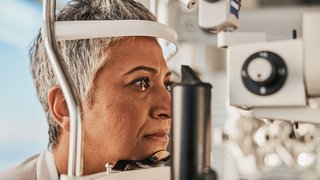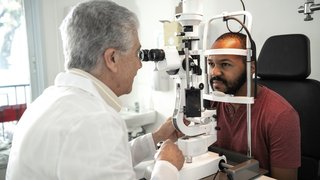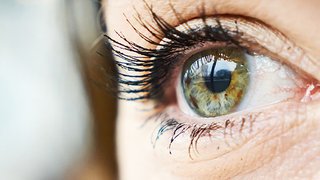Understanding uveitis: A vision-threatening but treatable eye disease
July 28, 2022

While the eyes are among our smallest organs, they provide an invaluable window into whole-body health. A direct conduit to the brain, the eyes work in concert with the nervous, muscular, and vascular systems to help the body function and respond to outside stimuli.
Many chronic illnesses cause eye complications throughout our lifetimes, including diabetes and high blood pressure. Uveitis is a rare inflammatory disease of the middle layer of the eye (the uvea).
Uveitis affects just 38 per 100,000 people, but like most autoimmune diseases, it often presents in patients younger than 40 years of age and is the fourth leading cause of blindness among younger patients in the Western world.
Common symptoms of uveitis
In almost every case, the patient has done nothing “wrong” to cause their symptoms, which can include:
- Blurred vision
- Dark spots or lines in the field of vision (floaters)
- Eye pain
- Sensitivity to light
- Severe eye redness
What causes uveitis
While approximately 60% of uveitis cases affect the eyes only, 40% are associated with inflammation in other areas of the body. For example, uveitis can arise due to underlying autoimmune diseases, such as:
- Ankylosing spondylitis
- Crohn’s disease
- Multiple sclerosis
- Psoriasis
- Rheumatoid arthritis
- Sarcoidosis
- Lupus
Because uveitis is uncommon, it often goes undetected or misdiagnosed until severe complications develop. Untreated uveitis can lead to vision loss. However, when properly diagnosed, uveitis is treatable and can be well controlled with appropriate medications.
Most ophthalmologists may see a few cases of uveitis per year. Many hospitals – and even academic medical centers – do not have a uveitis specialist. As a uveitis specialist, I am trained to diagnose and treat this uncommon condition, including the management of my patients’ immunosuppressive therapies.
Seeking ongoing or follow-up care from a specialist will improve your chances of getting your uveitis into remission and maintaining disease remission.
How uveitis is diagnosed
An ophthalmologist will dilate your eyes and perform a thorough examination. The doctor will also ask detailed questions about your symptoms and medical history. We may recommend tests to determine the cause of an infection, if necessary.
What are the types of uveitis?
Uveitis is typically an acute disease, meaning symptoms start suddenly. The types of uveitis are classified by which portions of the eye are inflamed rather than the degree of severity:

- Anterior uveitis is the most common and least serious type. It is often called “iritis” because of inflammation in the iris – the colored part of the eye.
- Intermediate uveitis, or “iridocyclitis,” involves the middle portion of the eye including the vitreous, which is the fluid that fills the eye.
- Posterior uveitis affects the back portion of the eye, including the retina and the choroid, which delivers blood to the back of the eye. This type is sometimes called “choroiditis.”
- Panuveitis is inflammation throughout the eye.
What are the risk factors of uveitis?
Patients over 60, those with long-term uveitis, and some who have uveitis in the middle or back of the eye might be at increased risk of complications. If left untreated, uveitis can cause long-term problems such as:
- Cataracts, which cloud the lens of the eye
- Damage to the optic nerve that can lead to vision loss
- Detachment of the retina
- Glaucoma, when fluid can’t drain from the eye leading to increased pressure in the eye
- Macular edema, or swelling of the retina
- Retina scarring in spots, which can lead to vision loss
- Permanent vision loss
Treatments for uveitis
When treating uveitis, we must determine if the inflammation is isolated to the eye only, or if there are any underlying systemic diseases triggering it. If left untreated or undertreated, systemic autoimmune diseases such as rheumatoid arthritis and sarcoidosis will continue to cause recurring uveitis.
Patients with an identifiable underlying systemic disease often are referred to our other specialists to address infections or autoimmune diseases, which can damage organs throughout the body. Once those conditions are under control, uveitis symptoms typically start to improve in conjunction with eye-specific treatments.
In my uveitis research, I’ve described the successful use of several types of immunosuppressive medications to induce disease remission.
Jennifer Cao, M.D.
To treat eye inflammation, the U.S. Food and Drug Administration (FDA) has approved several classes of steroid drugs that may be administered as drops placed directly in the eye, pills, or injections. In rare cases, surgery is necessary to implant a small device that releases doses of steroids at regular intervals.
While steroids are an effective short-term treatment to reduce inflammation, their long-term use can lead to side effects such as glaucoma, cataracts, or delayed healing. Thus, if uveitis is chronic or recurrent, we turn to systemic immunosuppressants to help us gain long-term disease remission. Many of these medications are the same as those used to treat systemic autoimmune diseases such as Crohn’s disease and rheumatoid arthritis.
Because uveitis is an orphan disease, affecting fewer than 200,000 people nationwide, most treatments are considered off-label use. However, the FDA recently approved the use of Humira (adalimumab) for certain types of autoimmune uveitis. Humira blocks production of the TNF-alpha protein, which contributes to the eye inflammation that typifies uveitis.
In my research, I’ve described the successful use of several types of immunosuppressive medications to induce disease remission. In one study, with careful selection of patients, I was able to use the drug infliximab to treat pediatric uveitis patients with very high positive response rates and significant reductions in the amount of steroid dependence.
Although it’s classified as a rare disease, uveitis is more common than people might expect – and effective diagnosis and treatment requires specialized care. I feel fortunate to treat patients in a tertiary academic institution, where I can really use the multidisciplinary connections to provide the best coordinated care possible for patients in the region.
When to seek medical advice
The eyes can tell a world of information about your overall health. If you notice vision changes, ask an ophthalmologist whether uveitis – or an underlying autoimmune condition – might be the cause. We will provide you with specialized care that can help you see and feel better.
To talk with an ophthalmologist, call 214-645-8300 or request an appointment online.
A close-up view of ophthalmology care
UT Southwestern's eye care specialists treat the full spectrum of conditions affecting your vision, including glaucoma, diabetic retinopathy, corneal disease, and much more. They employ the most advanced research, technology, and techniques to safeguard your vision.











